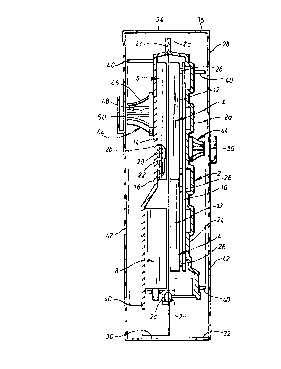Une partie des informations de ce site Web a été fournie par des sources externes. Le gouvernement du Canada n'assume aucune responsabilité concernant la précision, l'actualité ou la fiabilité des informations fournies par les sources externes. Les utilisateurs qui désirent employer cette information devraient consulter directement la source des informations. Le contenu fourni par les sources externes n'est pas assujetti aux exigences sur les langues officielles, la protection des renseignements personnels et l'accessibilité.
L'apparition de différences dans le texte et l'image des Revendications et de l'Abrégé dépend du moment auquel le document est publié. Les textes des Revendications et de l'Abrégé sont affichés :
| (12) Demande de brevet: | (11) CA 2261555 |
|---|---|
| (54) Titre français: | APPAREIL ELECTRONIQUE MUNI D'UN BOITIER HERMETIQUE |
| (54) Titre anglais: | ELECTRONIC APPARATUS HAVING AN ENVIRONMENTALLY SEALED EXTERNAL ENCLOSURE |
| Statut: | Réputée abandonnée et au-delà du délai pour le rétablissement - en attente de la réponse à l’avis de communication rejetée |
| (51) Classification internationale des brevets (CIB): |
|
|---|---|
| (72) Inventeurs : |
|
| (73) Titulaires : |
|
| (71) Demandeurs : |
|
| (74) Agent: | KIRBY EADES GALE BAKER |
| (74) Co-agent: | |
| (45) Délivré: | |
| (22) Date de dépôt: | 1999-02-10 |
| (41) Mise à la disponibilité du public: | 1999-09-24 |
| Requête d'examen: | 1999-02-10 |
| Licence disponible: | S.O. |
| Cédé au domaine public: | S.O. |
| (25) Langue des documents déposés: | Anglais |
| Traité de coopération en matière de brevets (PCT): | Non |
|---|
| (30) Données de priorité de la demande: | ||||||
|---|---|---|---|---|---|---|
|
Electronic apparatus is disclosed having components
mounted within an environmentally sealed external enclosure.
The enclosure comprises a casting of heat conductive
material and ones of the components are mounted in heat
conductive association with one or more walls of the
enclosure. These one or more walls have external pin fins
projecting therefrom.
Conventional extended surfaces are, in effect, flat
strips extending a significant distance along the surface of
the enclosure. The pin fins of the present invention
improve cooling compared with conventional fins. The
enclosure may be lighter in weight than an enclosure that
has conventional fins.
Note : Les revendications sont présentées dans la langue officielle dans laquelle elles ont été soumises.
Note : Les descriptions sont présentées dans la langue officielle dans laquelle elles ont été soumises.

2024-08-01 : Dans le cadre de la transition vers les Brevets de nouvelle génération (BNG), la base de données sur les brevets canadiens (BDBC) contient désormais un Historique d'événement plus détaillé, qui reproduit le Journal des événements de notre nouvelle solution interne.
Veuillez noter que les événements débutant par « Inactive : » se réfèrent à des événements qui ne sont plus utilisés dans notre nouvelle solution interne.
Pour une meilleure compréhension de l'état de la demande ou brevet qui figure sur cette page, la rubrique Mise en garde , et les descriptions de Brevet , Historique d'événement , Taxes périodiques et Historique des paiements devraient être consultées.
| Description | Date |
|---|---|
| Inactive : CIB de MCD | 2006-03-12 |
| Demande non rétablie avant l'échéance | 2004-02-10 |
| Le délai pour l'annulation est expiré | 2004-02-10 |
| Réputée abandonnée - les conditions pour l'octroi - jugée non conforme | 2003-04-16 |
| Réputée abandonnée - omission de répondre à un avis sur les taxes pour le maintien en état | 2003-02-10 |
| Un avis d'acceptation est envoyé | 2002-10-16 |
| Lettre envoyée | 2002-10-16 |
| Un avis d'acceptation est envoyé | 2002-10-16 |
| Inactive : Approuvée aux fins d'acceptation (AFA) | 2002-10-01 |
| Modification reçue - modification volontaire | 2002-07-08 |
| Inactive : Dem. de l'examinateur par.30(2) Règles | 2002-04-15 |
| Demande publiée (accessible au public) | 1999-09-24 |
| Inactive : Page couverture publiée | 1999-09-23 |
| Symbole de classement modifié | 1999-04-01 |
| Inactive : CIB en 1re position | 1999-04-01 |
| Inactive : CIB attribuée | 1999-04-01 |
| Inactive : Transfert individuel | 1999-03-31 |
| Inactive : Lettre de courtoisie - Preuve | 1999-03-16 |
| Inactive : Certificat de dépôt - RE (Anglais) | 1999-03-12 |
| Exigences de dépôt - jugé conforme | 1999-03-12 |
| Demande reçue - nationale ordinaire | 1999-03-12 |
| Exigences pour une requête d'examen - jugée conforme | 1999-02-10 |
| Toutes les exigences pour l'examen - jugée conforme | 1999-02-10 |
| Date d'abandonnement | Raison | Date de rétablissement |
|---|---|---|
| 2003-04-16 | ||
| 2003-02-10 |
Le dernier paiement a été reçu le 2001-12-28
Avis : Si le paiement en totalité n'a pas été reçu au plus tard à la date indiquée, une taxe supplémentaire peut être imposée, soit une des taxes suivantes :
Veuillez vous référer à la page web des taxes sur les brevets de l'OPIC pour voir tous les montants actuels des taxes.
| Type de taxes | Anniversaire | Échéance | Date payée |
|---|---|---|---|
| Requête d'examen - générale | 1999-02-10 | ||
| Enregistrement d'un document | 1999-02-10 | ||
| Taxe pour le dépôt - générale | 1999-02-10 | ||
| TM (demande, 2e anniv.) - générale | 02 | 2001-02-12 | 2000-12-20 |
| TM (demande, 3e anniv.) - générale | 03 | 2002-02-11 | 2001-12-28 |
Les titulaires actuels et antérieures au dossier sont affichés en ordre alphabétique.
| Titulaires actuels au dossier |
|---|
| LUCENT TECHNOLOGIES INC. |
| Titulaires antérieures au dossier |
|---|
| WILLIAM GEORGE GATES |